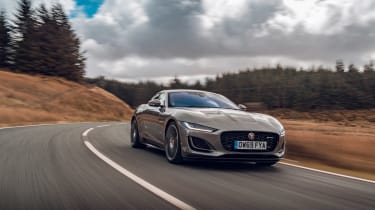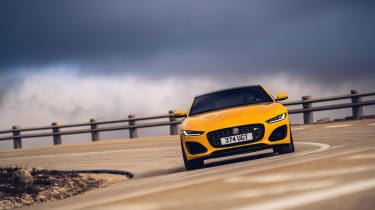Jaguar F-Type (2020 - 2024) facelift – ride and handling
An inherently well balanced and playful chassis is in there, but different models have different issues
Regardless of its age, the top-level F-Type R is still very entertaining. Much of that comes from the delivery and sound of the supercharged V8, which is as boisterous, vocal and responsive as ever. Leaving the line in a hurry is very easy indeed, with huge straight-line traction and strong power delivery thanks to the lag-free nature of the supercharger. Shifts from the eight-speed are brisk, though Jag’s fiddling with the software has introduced a frustrating thump to the changes at high rpms in Dynamic mode. Jaguar deems it appropriate for a sports car, but ‘irritating’ is the first word that springs to mind when driving it.
That said, overall it feels just a little more relaxed than before, as if Jaguar has tuned out some of the overly jumpy nature that could catch out the previous R. It’s still hyper-responsive to throttle inputs in Dynamic particularly, but even on damp roads it doesn’t seem to overwhelm the rear tyres quite as easily as it used to.
> Jaguar F-type (2013 - 2019) pre-facelift review
Just as the power delivery seems a little less hyperactive, so too does the chassis seem more in tune with your inputs. The new steering ratio is slightly more relaxed than before, and easier on the self-centring than some other recent Jags, including the new P450. The benefits are numerous: better feedback, less muscle required on a twisty road, and less chance of unsettling the F-Type’s bulk when you’re tipping it through a tricky turn.
More reviews
In-depth reviews
- Jaguar F-Type (2020 - 2024) facelift review – flying the flag for the great British sports car
- Jaguar F-type (2013 - 2019) review – stunning looks and still able to thrill on the road
Reviews
- Jaguar Project 7 (2015 - 2016) review – the peak of Jaguar's outgoing era?
- Used Jaguar F-Type (2013 - 2024) review and buyer’s guide
- Lister Thunder review – is 666bhp too much?
- Jaguar F-type 400 Sport review - sharper V6 nibbles at F-type R's heels
- 2017 Jaguar F-type SVR review – small tweaks to the top-of-the-range F-type
- Jaguar F-Type SVR Convertible review - a 567bhp assault on the senses
Jaguar has been keen to give the car a rear-wheel-drive feel, and it’s worked – from the moment you turn in the car takes a poised stance, and from there you can get on the power and feel the car pushing you along rather than dragging from the front. There’s plenty of turn-in bite and good mid-corner grip, and while you can feel the weight moving around under braking or when you need to flick from one direction to another, the body is well controlled.
Throw in strong stoppers and a mature ride (not to mention a cabin that has enjoyed a few quality tweaks as well as improved infotainment, and revised styling that still turns heads) and the F-Type continues to neatly bridge the gap between sports car and GT. And the fun factor, thanks to the balanced chassis and monstrous power output, is as present as ever.
The P300’s one key advantage over the V8 models is the more balanced chassis that allows the lighter body to flow with the road with increased sophistication and fluency. Unfortunately, this is offset by the four-cylinder’s lack of focus. The P300 doesn’t exercise its improved agility due to the tepid performance, the smaller brakes lack bite and the inability to really key into the road surface. Push harder and its open rear differential makes hard acceleration scrappy, which only distances you even further from a powertrain that already feels remote and unresponsive.






